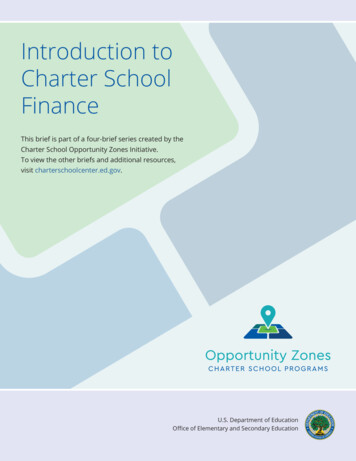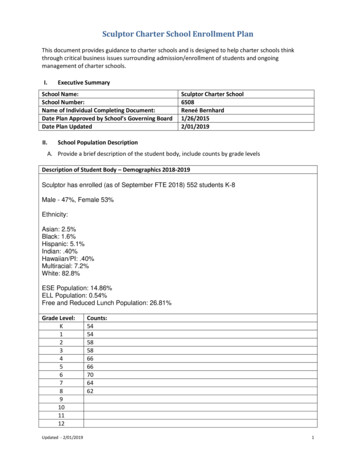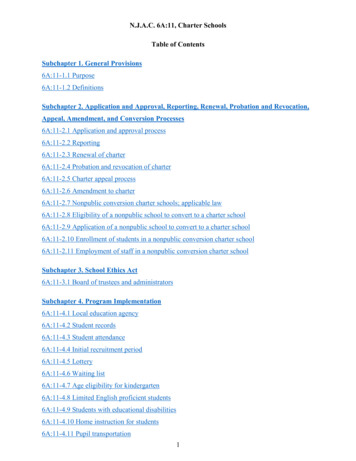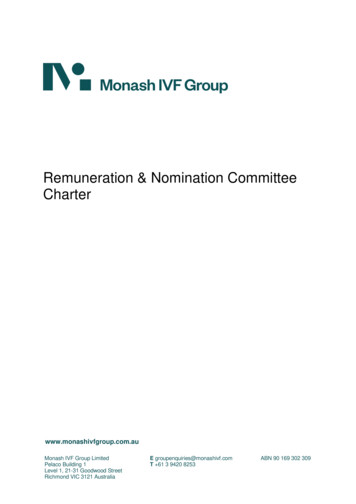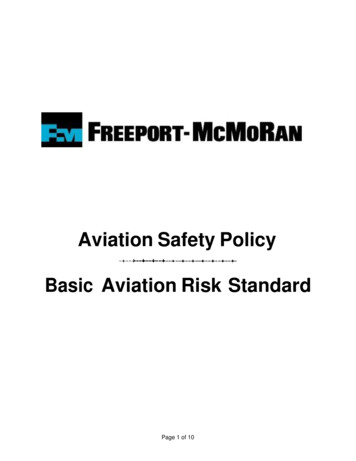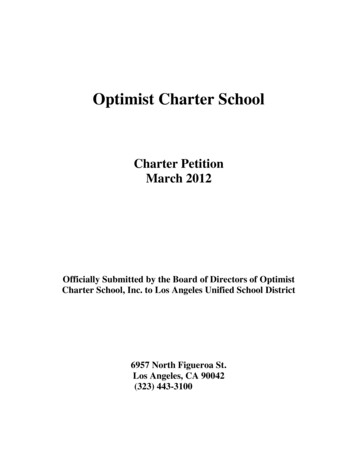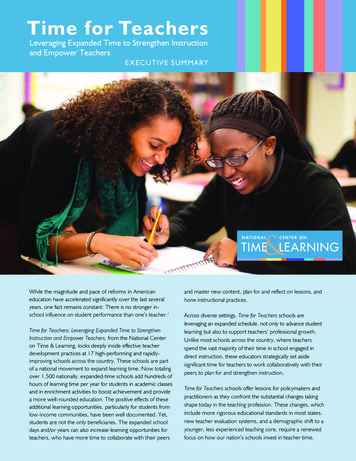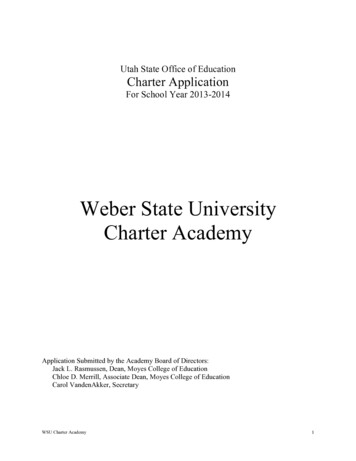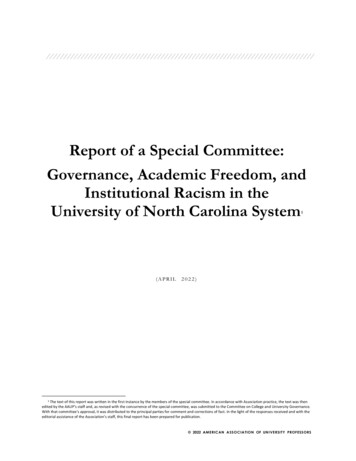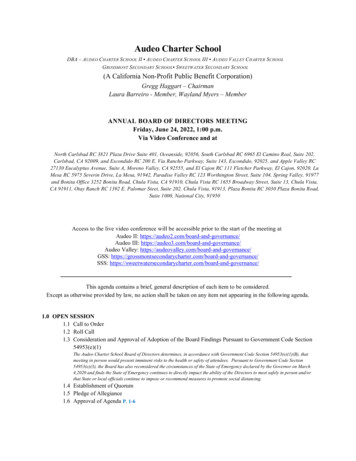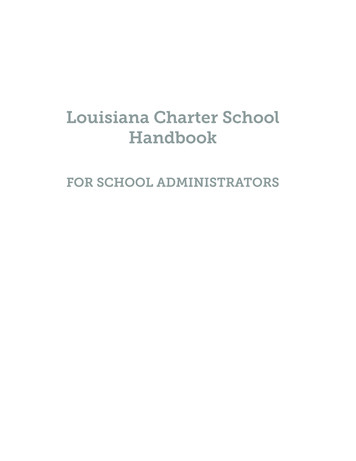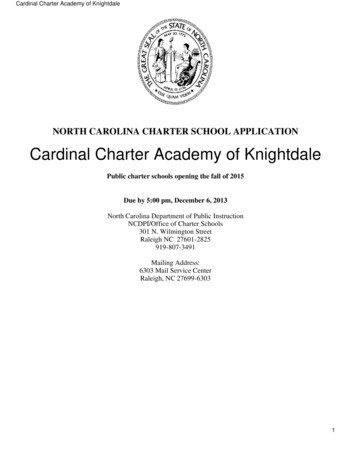
Transcription
Cardinal Charter Academy of KnightdaleNORTH CAROLINA CHARTER SCHOOL APPLICATIONCardinal Charter Academy of KnightdalePublic charter schools opening the fall of 2015Due by 5:00 pm, December 6, 2013North Carolina Department of Public InstructionNCDPI/Office of Charter Schools301 N. Wilmington StreetRaleigh NC 27601-2825919-807-3491Mailing Address:6303 Mail Service CenterRaleigh, NC 27699-63031
Cardinal Charter Academy of KnightdaleOCS August 2012CHARTER SCHOOL2013 Application ProcessTo open a charter school in the 2015-2016 school yearAPPLICATION DUE DATE/TIMESeptember 6, 2013A letter of intent to apply for the 2015-2016 school year must be received electronically toDeanna Townsend-Smith in the Office of Charter Schools no later than 12:00 noon atdeanna.townsend-smith@dpi.nc.gov. If the Letter of Intent is not submitted, anapplication from this group will not be accepted. You can find the Letter of Intentrequirements on the NC Office of Charter School web site.December 6, 2013A complete online application package, in the Office of Charter Schools by 5:00 pm.December 13, 2013 A copy of the application due to the Local Education Agency in which the proposed charterschool will reside in. Applicant must provide an attached PDF version as evidence to theOffice of Charter Schools (i.e. signed letter).APPLICATION SPECIFICATIONSApplicants can submit applications prior to the deadline December 6, 2013 at 5:00 pm. All applicants must besubmitted using the online portal and applicants are to use the following specifications:1. All required Appendices should be clearly titled, include page numbers (i.e. Appendix A and pagenumbers as- A1, A2, B1.), and submitted as a FULL PDF document.2. Review all elements of your application for completeness before submitting. An incomplete applicationwill result in the elimination of the application.3. Late submissions will not be accepted. No exceptions.4. Provide confirmation electronically to the Office of Charter Schools to deanna.townsend-smith@dpi.nc.gov that within seven (7) days the applicant has provided one full copy of the application tothe LEA in which the proposed charter school will be located.2If you have questions regarding the application process, please contact the Office of Charter Schools via email atdeanna.townsend-smith@dpi.nc.gov.
Cardinal Charter Academy of KnightdaleTABLE OF CONTENTSI.APPLICATION CONTACT INFORMATION5Grade Levels Served and Total Student Enrollment:5II.MISSION and PURPOSESMission:Educational need and Targeted Student Population of the Proposed Charter School:Purposes of the Proposed Charter School:Goals for the Proposed Charter School:III.EDUCATION PLANInstructional Program:C7779111414K-5 Curriculum and Instructional Design:C6-8 Curriculum and Instructional Design:C15Special Programs and "At-Risk" Students24Exceptional Children28Student Performance Standards32Student Conduct:33IV.GOVERNANCE, OPERATIONS and CAPACITYGovernance:203636Governance and Organizational Structure of Private Non-Profit Organization:36Proposed Management Organization (Educational Management Organization or Charter ManagementOrganization)42Private School Conversions: complete46CProjected Staff:46Staffing Plans, Hiring, and Management46Staff Evaluation and Professional Development50Enrollment and Marketing:Marketing PlanParent and Community InvolvementAdmissions PolicyPROJECTED ENROLLMENT 2015-16 through 2019-20205353535557Transportation Plan:58School Lunch Plan:Civil Liability and InsuranceHealth and Safety Requirements:Facility:585959Facility Contingency Plan:60V.FINANCIAL PLANBudget: Revenue Projections from each LEA 2015-16Total Budget: Revenue Projections 2015-16 through 2019-2020Personnel Budget: Expenditure Projections 2015-16 through 2019-2020Operations Budget: Expenditure Projections 2015-16 through 2019-2020Overall Budget:Budget Narrative:Financial Audits:VI.AGREEMENT PAGE616263666868763If you have questions regarding the application process, please contact the Office of Charter Schools via email atdeanna.townsend-smith@dpi.nc.gov.
Cardinal Charter Academy of KnightdaleLEA Impact Statement:77Applicant Signature:774If you have questions regarding the application process, please contact the Office of Charter Schools via email atdeanna.townsend-smith@dpi.nc.gov.
Cardinal Charter Academy of KnightdaleI. APPLICATION CONTACT INFORMATIONName of proposed charter school: Cardinal Charter Academy of KnightdaleHas the organization applied for 501(c)(3) non-profit status:YesNo XName of non-profit organization under which charter will be organized or operated: TriangleCharter Education AssociationProvide the name of the person who will serve as the primary contact for this Application. The primarycontact should serve as the contact for follow-up, interviews, and notices regarding this Application.Name of contact person: Allen TaylorTitle/Relationship to nonprofit: PresidentMailing address:7917 Bluffridge DriveRaleigh NC 27615Primary telephone: 919-846-3433Alternative telephone: 770-500-9037E-Mail address: allen.taylor@hatterasfunds.comName of county and local education agency (LEA) in which charter school will reside:County: WAKELEA: 920-Wake County SchoolsIs this application a Conversion from a traditional public school or private school?No: XYes:Is this application being submitted as a replication of a current charter school model?No: XYes:What is the name of the nonprofit organization that governs this charter school? Triangle CharterEducation AssociationIs this application for Virtual charter school: Yes:No: XGrade Levels Served and Total Student Enrollment:Projected School Opening: Year 2015Month AugustWill this school operate on a year round schedule?No: XYes:Proposed Grade Levels Served and Total Student Enrollment (10Years)5If you have questions regarding the application process, please contact the Office of Charter Schools via email atdeanna.townsend-smith@dpi.nc.gov.
Cardinal Charter Academy of KnightdaleAcademicSchool YearFirst YearSecond YearThird YearFourth YearFifth YearSixth YearSeventh YearEight YearNinth YearTenth YearGrade al ProjectedStudent e State Board of Education provides funds to charter schools, approves the original members of theboards of directors of the charter schools, has the authority to grant, supervise, and revoke charters,and demands full accountability from charter schools for school finances and student performance.I certify that I have the authority to submit this application and that the initial board members and I wereregularly involved in the development of this application. All information contained herein is completeand accurate. I realize that any misrepresentation will result in disqualification from the applicationprocess or revocation after award. I understand that incomplete applications will not be considered.The person named as the contact person for the application is so authorized to serve as the primarycontact for this application on behalf of the non-profit organization.ataylor26SignatureAllen Taylor, PresidentTitleataylor26Printed Name12/06/2013Date6If you have questions regarding the application process, please contact the Office of Charter Schools via email atdeanna.townsend-smith@dpi.nc.gov.
Cardinal Charter Academy of KnightdaleII. MISSION and PURPOSES(No more than three total pages in this section)Mission:State the Mission of the proposed charter school in one hundred words or less. The missionstatement defines the organization's purpose and primary objectives, describing why it exists. Themission statement provides the foundation for the entire proposal.The mission statement of the proposed charter school is as follows:The mission of Cardinal Charter Academy of Knightdale is to build a studentcentered learning environment that is project-based and technology-driven inwhich students can reach their academic potential and prepare for success intheir post-secondary studies and professional careers. We value academicsuccess through the use of data to meet the individual and diverse needs ofeach student. The Academy will foster a culture of innovation and inquiryusing technology as the medium.Educational need and Targeted Student Population of the Proposed Charter School:1. Provide a description of Targeted Population in terms of demographics. In your description,include how this population will reflect the racial and ethnic composition of the school system inwhich it is located. Describe the rationale for selecting the location and student body.Cardinal Charter Academy at Knightdale (the "Academy")will be governed bythe Triangle Charter Education Association ("Board").Cardinal Charter Academy will be open to all students in North Carolina.However, given the strong proximity relationship of a schools enrollment toits physical location, we anticipate most students to come from within a 5mile radius of Knightdale.Knightdale AreaEnrollment: 3,612White%: 18.90%Non-White%: 81.10%FRL%:72.85%Special Education%:LEP%: N/AN/AWake CountyEnrollment: 149,336White%: 49.16%Minority%: 50.84%FRL%: 38.57%Special Education%: 13.33%LEP%: 7.7%The Knightdale area above was measured using data from 5 public non-highschools in the region, and includes data from at least one middle school.7If you have questions regarding the application process, please contact the Office of Charter Schools via email atdeanna.townsend-smith@dpi.nc.gov.
Cardinal Charter Academy of KnightdaleThe 14 charter schools in Wake County have non-white student enrollmentproportions averaging 45.68%, which slightly exceeds the non-Whitepopulation across Wake County. However, our Academy anticipates serving amuch higher minority population relative to Wake County schools due tooutreach in the Knightdale community, which has an FRL rate of almost 73%.The Board chose Wake County primarily because of overcrowding; Wake Countyis also facing significant capacity issues; the county recently allocated 873,418,900 over 5 years (into 2015-16) toward school construction,renovation, and expansion. The proposed Academy will be built with privatecapital without any expense to the taxpayer.The Board also considered school performance in the area.The countypossessed 1 of the states 160 Priority schools as of 2011-12, which aredefined as being among the lowest 5% of Title 1 schools in the state. Thatschool had an average Performance Composite score of 58.1%, which is almosttwenty percentage points below the state average of 75.9%. In addition tothe Priority school, Wake County also contained 15 of the states 130 Focusschools, which is defined as having a significant in-school achievement gap.2. What will be the total projected enrollment at the charter school and what percentage of theAverage Daily Membership (ADM) does that reflect when compared to the Local EducationAgency (LEA) of the same offered grade levels? (i.e. If the proposed school will be grades 9-12,only compare the total enrollment to the total enrollment of the LEA is grades 9-12).Wake County has over 107,138 students and is the largest enrollment marketin the state. Cardinal Charter Academy at maximum capacity will only enroll1,145 students which represent 1.1% of the county's current totalenrollment.3. Explain how the charter school's education plan will compare to or differ from that of the localLEA(s).Through partnership with Charter Schools USA (CSUSA or EMO), the Academywill implement several innovative concepts that differ from that of thelocal LEA. Please see Appendix T for additional overview of how the Academywill deliver an innovative model to the community.The Academy will focus on mastery of standards through offering a Guaranteedand Viable Curriculum ("GVC"). The Academy will also: implement a datadriven Educational Model and Personalized Learning Plans ("PLP"); keepstudents and parents involved and informed through a student informationsystem; and ensure continued professional development and learningenvironment accountability by utilizing Quality Education for Student andTeachers ("QUEST") school visits and weekly walk-throughs. The Academy mayalso differ by utilizing technology to foster inquiry, innovation andprovide opportunities for blended learning; differentiating through the useof note-taking and summarizing strategies for the 21st century, and buildingresearch abilities through discovery learning. Members of the leadershipteam will meet with teachers on a weekly basis for professional developmentand data analysis to help guide data-driven instruction.The K-8 grade configuration is an innovative design that allows students tofocus on their academics in their middle school years, versus focusing onthe social issues associated with transitioning to a new school. This model8If you have questions regarding the application process, please contact the Office of Charter Schools via email atdeanna.townsend-smith@dpi.nc.gov.
Cardinal Charter Academy of Knightdaleallows families to establish solid relationships with the staff at theschool, creating a greater sense of a community. Middle school students in aK-8 building also have opportunities to establish leadership roles asmentors for the younger elementary students.Additionally, each year CSUSA will conduct at least two parent surveys. Thefirst survey will take place in the fall, around October, is designed togauge parental satisfaction and identify any early issues that might bearising in the Academy. A similar survey in the spring, around April, helpsto take a look back over the year to understand our strengths and areaswhere improvements can be made. These surveys will capture parent feedbackon a wide range of topics from curriculum, engagement, safety, satisfaction,loyalty, and the quality of service delivery at the Academy. CSUSA will alsowork closely with the principal to align the survey administration with anyparental events. This allows parents to not only take the survey but, toalso reflect on their experience at the Academy and communicate directlywith the staff. The results of the survey will be collected centrally andanalyzed for presentations to different audiences. Survey results will bepresented to the principal, who will communicate them to relevantstakeholders, as well as CSUSA leadership. The results of the survey will beimplemented in many applications from day to day planning within theAcademy, community outreach,identifying issues in the Academy, as well asschool-wide goal setting.The principal will monitor instruction with weekly walk-throughs to ensureimplementation of the instructional strategies (as described in EducationPlan). Teachers will receive professional development in weekly Curriculum,Instruction, and Data ("CID") meetings and obtain feedback based upon schoolvisits, to support effective classroom instruction.We will use unique and innovative academic components to complement thedata-driven Educational Model which include: school-wide goal setting;Personalized Learning Plans; Instructional Focus Plans; blended learning;character education; academic intervention and acceleration; and technologyto support student engagement. Meaningful parental engagement is alsoessential to the Academy's ationandcommunityintegration through which character and academic education meet throughextracurricular and auxiliary activities.4. In the appendices (Appendix A), you must provide evidence through a narrative or visual of thiseducational need through survey data, or times and locations of public meetings discussing thisproposed charter school. (Please do not provide more than one sample survey form).Purposes of the Proposed Charter School: In one page or less, describe how the proposed charterschool will achieve one or more of the six legislated purposes, as specifically addressed in the NCcharter school statute GS 115C-238.29A, and the proposed school's operations.The Six Legislative Purposes of a Charter School are:1. Create new professional opportunities for teachers, including the opportunities to be responsiblefor the learning program at the school site.9If you have questions regarding the application process, please contact the Office of Charter Schools via email atdeanna.townsend-smith@dpi.nc.gov.
Cardinal Charter Academy of Knightdale2. Hold schools accountable for meeting measurable student achievement results.3. Provide parents and students with expanded choices in the types of educational opportunitiesthat are available within the public school system.4. Improving student learning.5. Increasing learning opportunities for all students, with a special emphasis on at-risk or giftedstudents.6. Encourage the use of different and innovative teaching methods.1. Create new professional opportunities for teachersNew teachers will participate in New Teacher Induction prior to commencementof each school year. All teachers will participate in Learning Communitythroughout the year, plus weekly data chats/team meetings, Teacher DataSummits, and ongoing professional development at the Academy and networklevel.Working in conjunction with CSUSA, teachers seeking leadershipopportunities will have the ability to take part in the Leading Edge Programwhich provides an avenue for teachers to take on a leadership role, whetherit is as a Curriculum Resource Teacher or an administrator.2. Hold schools accountableData will be tracked by CSUSA and reported to us regularly. The Academy willreceive extra support and additional monitoring from CSUSA, as needed.3. Provide parents/students with choiceThe Academy will meet the needs of families who demand more educationalopportunities for their children. The Academy will help to meet that demandand expand educational choices for parents and students of the communitywith the creation of a K-8 college preparatory education system that has akeen focus on stakeholder satisfaction. The Academy may also offer theCambridge International Primary Program. The Cambridge Program offers aninternational, pre-university curriculum and examination system thatemphasizes the value of a broad and balanced study for academically ablestudents. The Cambridge curriculum aims to encourage the skills ofindependent research and investigation, the use of initiative and creativityand the application of knowledge and skills. The board and CSUSA'scommitment to continuous measurement and improvement of stakeholdersatisfaction is supported by annual surveys. Annually, more than 90% ofstudents choose to return to CSUSA-managed schools and parent satisfactionmeasures exceed 90%.4. Improve student learningThe Guaranteed and Viable Curriculum ensures that students have both thetime and opportunity to learn and master the content expected of them withinthe Common Core State Standards ("CCSS") and NC Essential Standards. TheGuaranteed and Viable Curriculum combined with implementation of theEducational Model through continuous assessment of student performance dataand analysis of student learning gains are imperative to improving studentlearning and achieving the academic goals set forth in this application.5.Increase learning opportunities10If you have questions regarding the application process, please contact the Office of Charter Schools via email atdeanna.townsend-smith@dpi.nc.gov.
Cardinal Charter Academy of KnightdaleFree tutoring opportunities will be available outside of the regular schoolday in addition to the tutoring and intervention services providedthroughout the school day. This allows for increased learning opportunitiesfor students. For example, in the first 5 years at the Academy, the averageannual expenditure for tutoring resources is 40,000. Tutoring is free forstudents.6. Encourage the use of innovative teaching methodsAs outlined in this application, the Academy will encourage the use ofinnovative learning methods and deliver educational best practices to thestudents within the framework of a research-based Educational Model, whichis innovative in its approach to data analysis for individual esearch-basedinstructional strategies, founded upon the works of Robert Marzano, The Artand Science of Teaching (ASCD, 2007), provides students a unique opportunityfor their learning to be academically rigorous and challenging, yetinnovative and focused on individual student learning needs. Thesestrategies have been research-proven to yield positive results in studentlearning. From there, professional development, specific to the grade level,is provided to help teachers create and implement an instructional frameworkthat guides them as to the most appropriate use of these strategies andinnovative learning methods.As new research is released and updated, professional development andteaching strategies are continuously updated to meet the needs of students.Utilization of PLPs empowers students to track their own progress, whichinitiates student ownership of learning goals. Through analysis andevaluation of data, each student, with the assistance of administrators,teachers, and parents are able to devise an academic plan to achievelearning gains. These innovative teaching methods align with our mission ofbuilding a student-centered learning environment and fostering a culture ofinnovation and inquiry using technology as the medium.Goals for the Proposed Charter School:1. Provide specific and measurable student achievement performance goals for the school'seducational program and the method of demonstrating that students have attained the skillsand knowledge specified for those goals. Address how often and when the information will becommunicated to the governing board and other stakeholders. These goals should includespecific and measurable performance objectives over the first five years of the schoolsexistence.Proficiency GoalSpecific: Each year, on the End of Grade (EOG) or End of Course (EOC)assessments in Math, Reading and Science, the Academy will see a significantincrease in the percentage of "Proficient" students (as defined by thosescoring "At or Above Grade Level"). In 2014-15, Smarter Balanced Assessments(SBAC) are set to replace many EOG and EOC tests.Measurable: Math, Reading and Science EOG and EOC (SBAC when available)scores for students in third through eighth grade, will reflect at least a10% reduction in the number of students who are NOT "Proficient" relative tothe previous year. The Academy's EOG, EOC and SBAC scores in Year 1 willestablish the baseline for measuring this goal. EOG, EOC, and SBAC scores inthe second year will allow for the initial comparison to the baseline.11If you have questions regarding the application process, please contact the Office of Charter Schools via email atdeanna.townsend-smith@dpi.nc.gov.
Cardinal Charter Academy of KnightdaleAttainable: We believe this goal is attainable, given that our students willhave the appropriate resources and access to high quality teachers.Relevant: This goal is relevant to the Academy's mission, which states acommitment to build a student-centered learning environment that supportsindividualized needs.Time Bound: The establishment of a baseline will occur at the completion ofthe first full year of the charter. After that time, goals will be assessedannually, after EOG results are released in the spring.Growth GoalSpecific: Each year the Academy will meet 100% of its fall to spring GrowthTargets on each of the NWEA MAP benchmark assessments in Reading, LanguageUsage, Mathematics and General Science.Measurable: This goal is measured by student performance on the NWEA MAPbenchmark assessments. Students enrolled at the end of the year with validgrowth measures will be included in the grade level calculations of the"Percentage of Growth Targets Met" in Reading, Language Usage, Mathematicsand Science.Attainable: This goal is attainable with the programmatic, financial andhuman resources that will be available at the Academy.Relevant: This goal is relevant to the Academy's mission as students must besupported in reaching their academic potential.Time Bound: Actual growth targets to be reported annually.Closing the Achievement Gap GoalSpecific: Closing the achievement gap among student subgroups by meetingAMOs in each of the "At-Risk" student subgroups.Measurable: State reported outcomes of AMOs (with the application of aconfidence interval, as applicable). At the end of the Academy's first year,a baseline will be established. Progress toward the goal in subsequent yearswill be measured against the baseline that was established in Year 1.Attainable: This goal is attainable, as all students are capable of reachingproficiency, given appropriate resources and access to high qualityteachers.Relevant: The goal is relevant to the Academy's mission, which states acommitment to preparing students for success in their post-secondarystudies.Time Bound: After a baseline is established inYear 1, annual assessments.READY GoalSpecific: The Academy will meet or exceed Wake County performance in theREADY model components for all grades among schools with comparable studentdemographics.Measurable: Elementary and middle school grades will meet or exceed WakeCounty's performance, among comparable student demographics.Attainable: The Academy will have the academic, financial and humanresources necessary to meet or exceed the performance of its peer schools.Relevant:We recognize that school performance is a crucial to theAcademy's ability to attract and retain students as well as maintain parentsconfidence.Time Bound: Reported annuallyAttendance GoalSpecific: Average daily attendance will be 95% or higher each year12If you have questions regarding the application process, please contact the Office of Charter Schools via email atdeanna.townsend-smith@dpi.nc.gov.
Cardinal Charter Academy of KnightdaleMeasurable: Daily average of enrolled students in attendancestudents fromadministrators and parentsRelevant: Students must attend daily to be successful.Time Bound: Reported annuallyandtotalteachers,2. How will the governing board know that the proposed public charter school is working towardattaining their mission statement?Each month, the board will require CSUSA to prepare and submit a series ofreports that address student achievement, financial operations, schooloperations and school culture.The board's access to the informationcontained in the reports is crucial to evaluating how the Academy isprogressing toward attainment of the mission.CSUSA is committed toproviding these reports to us on a monthly basis; please see Appendix L fora schedule of board reporting.The use of student assessment and performance data is vital to the Academy'smission to increase academic success through the use of data to meet theindividual and diverse needs of each student, as evidenced by the Academy'sEducation Model (detailed in the Education Plan Section). Using a continuousimprovement process, the Academy will improve student learning andachievement, by regularly evaluating student performance to personalize andtarget instruction to each students needs. This data-driven cycle ofassessment, analysis, and action is indispensable for increasing studentachievement and is the top priority for school-wide improvement. Evaluationand assessment are critical aspects of curriculum implementation andimproving student achievement. Proper assessment verifies that students havesuccessfully acquired crucial skills and knowledge. Assessing studentperformance in core academic areas will be achieved in various ways,depending on the subject area.The Academy will monitor and evaluate specific, measurable goals regardingacademic performance. As detailed in Section II: Mission, Purpose and Goals,academic performance will be measured by increasing the percentage ofstudents who are proficient on the EOG, EOC and SBAC assessments, aligned tothe Common Core State Standards CCSS for 2015 and beyond, in math, readingand science. When SBAC assessments are unavailable, state EOG and/or EOCassessments will be used in its place. In the Academy's first year, theseproficiency levels will act as the baseline for future years assessmentgoals. A baseline year will also be used in years where the state introducesnew state-wide assessments. Additionally, all students will take diagnosticbenchmark assessments three times per year. Each student will be expected todemonstrate growth based on projected scale score (RIT scored) improvementsfrom one benchmark to the next. Nationally-normed benchmarks aligned to theCCSS will be used in the areas of reading, language usage and mathematics.The general science benchmark is aligned to the NC Essential Standards. Theboard will receive monthly updates of student progress from CSUSA and wewill ensure that CSUSA is meeting the mission, vision, and values of theAcademy.13If you have questions regarding the application process, please contact the Office of Charter Schools via email atdeanna.townsend-smith@dpi.nc.gov.
Cardinal Charter Academy of KnightdaleIII.EDUCATION PLAN(No more than ten total pages in this section)NOTE: All sections of the Education Plan should align with all other sections of this application. The StateBoard of Education shall give priority consideration to the applicants who demonstrate potential for significant,meaningful innovation in education. Provide precise and clear explanations. Lack of response to any question orproper documentation will deem the application incomplete.Instructional Program:Provide a detailed description of the overall instructional program of the proposed charter school, inc
Cardinal Charter Academy of Knightdale 1 NORTH CAROLINA CHARTER SCHOOL APPLICATION Cardinal Charter Academy of Knightdale Public charter schools opening the fall of 2015 Due by 5:00 pm, December 6, 2013 North Carolina Department of Public Instruction NCDPI/Office of Charter Schools 301 N. Wilmington Street Raleigh NC 27601-2825 919-807-3491 .
